I’ve recently written detailed reviews of all three new generation Pocket
PCs:
Casio E-115
Compaq iPAQ 3650
Hewlett Packard Jornada 548
In this review I’ll compare all three and help the buyer decide which (if any) is their best choice.
Physical Hardware Comparison:
Size wise the Casio E-115 is the largest Pocket PC followed by the HP 548 and then the iPAQ.
If we compare the machines when configured equally, the iPAQ jumps ahead as the biggest and heaviest. Configured equally means that the iPAQ has the CompactFlash card Expansion Pack attached. Without this pack, the iPAQ has no CF card
slot while the other 2 Pocket PCs do.

(Left to right: iPAQ, HP 548, E-115)
Size
| iPAQ without Expansion Pack | 5.11 x 3.28 x 0.62 in | 12.98 x 8.33 x 1.57 cm |
| iPAQ with Expansion Pack | 5.18 x 3.40 x 1.05 in | 13.16 x 8.64 x 2.67 cm |
| HP 548 without Flip Cover | 5.17 x 3.07 x 0.71 in (at thickest part) | 13.13 x 7.80 x 1.80 cm |
| HP 548 with Flip Cover | 5.17 x 3.07 x 0.96 in (at thickest part) | 13.13 x 7.80 x 2.44 cm |
| Casio E-115 | 5.16 x 3.29 x 0.91 in (at thickest part) | 13.11 x 8.36 x 2.31 cm |
Weight
| iPAQ without Expansion Pack | .410 lbs | 186 gm |
| iPAQ with Expansion Pack | .585 lbs | 265.35 gm |
| HP 548 without Flip Cover | .510 lbs | 231.33 gm |
| HP 548 with Flip Cover | .581 lbs | 263.54 gm |
| Casio E-115 | .563 lbs | 255.37 gm |
I found that the iPAQ (without the Expansion Pack) and HP 548 felt the best in my hand. They are both similar although a bit larger than a Palm IIIc. The HP-548 has a flip cover which is an advantage because you don’t have to have a case for it. The E-115 has the largest physical size and shape. It is more square and isn’t as comfortable to hold.
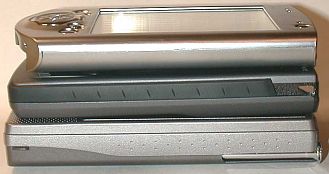
(Top to bottom: iPAQ, HP 548 (flip cover not attached), E-115)
Aesthetically, I find the HP 548 to be more pleasing to the eye. It is understated and simple. I also like the metal case. The iPAQ is just a bit too flashy for my personal tastes. I like the style of the Casio too but just wish it wasn’t so thick.
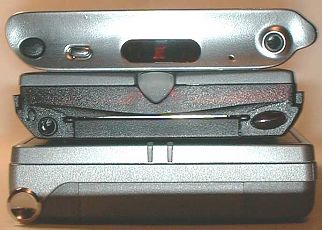
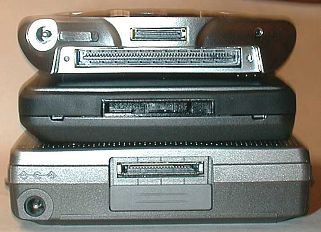
(Top to bottom: iPAQ, HP 548 (flip cover not attached), E-115)
Comparing the button placement of the three machines, I would say that they are all pretty much adequate for typical PDA functions. But, if you are a gamer, the Casio should be your choice. I say this for two reasons. One, the joypad and button placement on the front of the unit is very much like a Gameboy layout. Gameplay
feels natural and comfortable. The iPAQ has a large joypad in the middle of the unit. I find that this joypad isn’t as comfortable to use for games. Also, the
hardware design of the iPAQ prevents it from registering two button presses at once. For example, it won’t know that you’ve pressed both the UP button and the FIRE button. It will only see one
button press. The HP 548 doesn’t even have a joypad so as a result, some games will be very uncomfortable to
play on it.
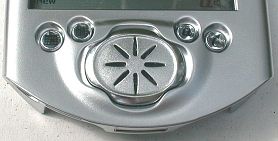
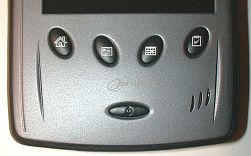
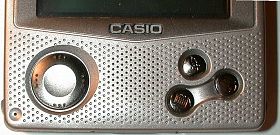
The audio quality of all three PDAs are just fine for alarms and listening to MP3 files. All three are loud enough to get your attention. The iPAQ is the loudest when set to maximum volume both externally and thru headphones. Next is the HP 548 and last is the E-115. For listening to MP3s thru the external speaker, I think the Casio has the best sound. But, it also has the lowest volume. I also think the Casio has the best stereo output thru headphones. Again, it has the lowest volume output when set at maximum but it is fine for me. Both the iPAQ and HP have more treble to their audio output. They don’t sound bad, just not as good as the Casio. This is really subjective though… and I don’t claim to be an audiophile.
Your main interface with any PDA is thru the display. The Casio E-115 has the best display hands down. It has the capability of displaying over 65,000 colors. The screen is bright and the colors are rich. Indoors and in the dark, it is excellent.
However, outdoors in sunlight, it is very hard to view the display. The iPAQ has the next best display. It is only capable of showing 4,096 colors though. The display is bright and sharp but the colors aren’t near as
rich as the Casio. But outdoors in any light, the iPAQ excels. It actually works great in the brightest sunshine. The HP has the worst display of the three. The display is grainy looking and takes a few seconds to ‘warm’ up to full brightness when you first power on the unit. The HP display like the iPAQ can only show up to 4,096 colors at once. I personally don’t have a problem with this limitation, but I do have a problem with lines and shapes bleeding down the screen. You also can’t view the HP display
easily outside in the sunlight.
Below is a picture that I took without flash in a dim room. I laid the PDAs
on a desk side by side. The Pocket PCs were set at their highest brightness
level. From left to right: iPAQ, HP 548, E-115.
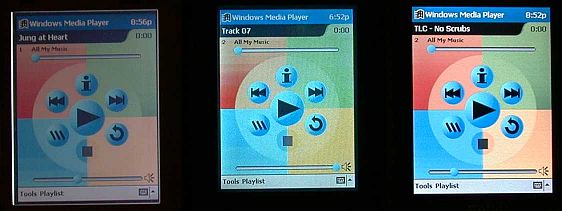
Below is another picture of the Pocket PCs outside on a bright day in full sun. From left to
right: iPAQ, HP 548, E-115.
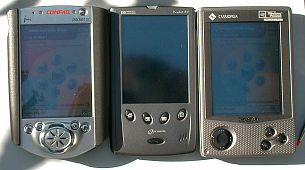
Here is another set of pictures that I took in a bright but shaded area. I tried
to stand in the same exact spot for each picture. As you can see, the iPAQ
really looks great.
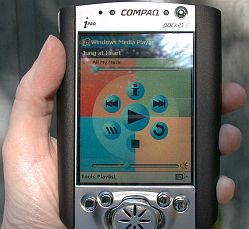
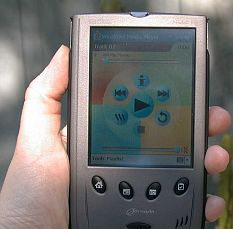
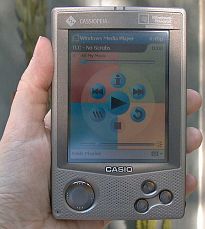
Ok, let’s talk desktop syncing now. The iPAQ and HP 548 both come with USB cradles. The E-115 has a serial cradle (The HP 548 also comes with a serial cable). USB is my
preferred method of syncing since you just plug it in and pretty much go. You don’t have to worry about a free comport or irq. At least that is the theory… There seems to be a BIG problem with the iPAQ and USB syncing. The iPAQ will connect to the desktop just fine once. Then, subsequent tries will result in failure and frustration. You can either reboot the PC or disable the USB sync in ActiveSync and then re-enable it. Either way, it’s a pain in the butt.
This is a problem that I have personally experienced and have read about others
experiencing. When it works, the iPAQ syncs the fastest of the three… The HP 548 doesn’t seem to have this trouble (at least on my PC… I have heard a few others complain though). USB syncing with the HP is faster than serial, but not near as fast as the iPAQ. Syncing with the E-115 using serial, is the slowest. But it is also the most reliable. I very rarely had a problem with connections timing out like on the other two units. If a PDA won’t sync fast and reliably, I get annoyed very
quickly. Here are some timing tests that I did on all three machines:
| 1067KB file transfer | 5019KB file transfer | |
| PC to HP 548 via USB Cradle | 38sec | 2mins 47 sec |
| PC to HP 548 via Serial Cable | 1min 51sec | 9mins 33 sec |
| PC to iPAQ via USB iPAQ Cradle | 14.04sec | 1min |
| PC to Casio E-115 via Casio Serial Cradle | 2min 32sec | 9mins 42 sec |
| PC to CF card via USB Sandisk CF Card Reader |
3sec | 11sec |
What about overall system speed? The iPAQ is by far the snappiest of the three. Opening applications and switching back and forth between apps is very fast. Rarely will you see the little timer thingy on the screen. Next fastest is the E-115. It is also snappy but once you use an iPAQ, you’ll then think it is slow. The HP 548 is
definitely the slowest of the three. Sometimes it will almost freeze to a crawl. I found that closing all the open applications seems to fix the problem.
You can find some good Pocket PC speed stats at this link.
Here are a few other hardware facts that need mentioning. The iPAQ uses Flash
ROM which means that the OS can be upgraded much more easily than the Casio or
HP units. The iPAQ has been known to get dust under the display which results in
glowing specs on your screen with the backlight is on. I have one such bit of
dust on my iPAQ. The HP’s CF card slot is a Type I slot which is not compatible
with the IBM MicroDrive. The HP is really easy to take apart. It has 4 screws on
the back. The Casio screen seems easier to scratch than the other screens. The
HP and Casio screens have a more paper feel to them then the iPAQ which feels
smooth like glass.
Each Pocket PC comes with a software bundle. Here is the rundown of what is
contained in each
bundle:
iPAQ:
QMenu-
Pop up task switcher and task closer tool. One of the hardware buttons on the
front of the iPAQ is mapped to this tool by default.
Qstart-
Compaq’s Program Launcher program. This program will allow you to add your own
categories that can be accessed from a pop up list at the bottom of the screen.
Qstart is also mapped to one of the hardware buttons by default. It’s a quick
launcher and is easy to use.
Asset Viewer-
Gives you simple outline view of the iPAQ hardware details.
Picture Viewer-
A very simple graphics viewer. Backup allows you to back up all your data to a
CF card… which you won’t be able to use unless you buy an optional Expansion
Pack.
Backup-
Allows you to backup your files to CompactFlash.
Optional files on the Compaq CDrom:
eWallet-
Allows you to store your personal information such as credit card numbers,
passwords, pin numbers etc.
ListPro-
Allows you to create hierarchical lists and outlines.
There is a splash file on the iPAQ for a program called PacketVideo Player.
This program is supposed to be a streaming video player. The splash screen tells
you to go download the latest version from their website or install it from the
enclosed CDrom. The file doesn’t exist on the CD and the website says the
program will be available next month… The Compaq CD also shows a program
called Formula 1 which looks like a race car game. But, this game isn’t
available to install.
E-115:
Casio Menu-
Casio’s own launcher app that is started when you press the Rocket button on the
front of the E-115.
Mobile Calendar-
Casio’s Calendar replacement app. This is a nice little app and could be a lot
better if was only faster. It gives you several views which I like much better
than the views that the built in Calendar uses.
Mobile Address Book-
Casio’s Contacts replacement app. I think this app is better than the built in
Contacts app. It has a nicer graphical appearance and layout. It allows you to
view by name or company name. You can also resize the columns so you can see the
info better.
Mail Setup Tool-
Nice Inbox set up wizard that helps you set up your pop server info for pulling
down email to your E-115 from your ISP via a modem.
Card Backup Tool-
Easy to use tool that lets you backup and restore your E-115 files
(files/data/registry) to CompactFlash.
AOL Setup-
Setup program to use your AOL account on your E-115.
Optional files on the Casio CD:
Button Assignment App-
This utility assigns CASIO Mobile Calendar to Button2 and CASIO Mobile Address
Book to Button3 on your CASSIOPEIA Pocket PC. I’m not sure why you need this as
there is a built in button assignment app in the regular settings area.
Mobile Camera-
Mobile Camera is a program that lets you record and playback snapshots and
movies. It also includes a number of functions for creating and viewing albums.
Mobile Video Player-
This application plays CASIO Movie Format files on the E-115.
Mobile Video Player for PC-
CASIO Mobile Video Player for PC is player software that lets you play CASIO
original movie format(CMF) files on your computer.
Mobile Video Converter-
The Mobile Video Converter works on your PC to convert most commonly-used
digital video formats
for viewing on the CASSIOPEIA. The following formats are currently supported:
MPEG1, AVI, and QuickTime(TM).
ZIOGolf Demo-
2 hole demo version of the popular golf game (Read my review).
Enterprise Harmony 99-
Transfers data from a Palm device to the E-115.
HP 548:
OmniSolve Calculator-
Full function forms based calculator from Landware. Solve in SAN or RPN modes,
Amortization, Interest rate conversions, Date calculations, Investment analysis,
Retail-style percentage calculations, Currency conversions, and Unit
conversions.
HP Home Menu-
Simple application launcher app that is similar to the Casio Launcher app. You
only get 2 pages of buttons (total of 21 buttons) that you can assign apps to.
There are also hard coded buttons that show the battery status, memory status,
launch display settings, and taskswitcher.
HP Task Switcher-
Built-in task switcher / task closer app. It just pops up a list of open apps
that you can tap on to switch to them. Then if you want to close the apps, you
tap on the Close Window option and another list pops up with the same list of
open apps and an option to close all. This is kind of redundant. They should
have just added the Close all option to the bottom of the first window since
there isn’t a way to selectively close apps. You either close them all or close
none.
HP Security App-
Easy to use security app that lets you pick a 4 digit code that you have to
enter in order to get into the HP when you power up. It also allows you to log
the login attempts.
HP Backup / Restore App-
Simple app that lets you back up all data or PIM data to internal or CF storage.
You can also restore all data or PIM data.
HP Game Button Settings App-
App that allows you to assign the different hardware buttons to different game
functions. For example, you can assign the Home button to LEFT, the Tasks button
to RIGHT, and the Action button to FIRE. You can also save different button
profiles so that you can load them in for different games.
Optional software on the HP CDrom:
AOL Mail-
Send and receive AOL mail via your Pocket PC.
Yahoo! Messenger-
Send and receive instant messages with other Yahoo! people online.
Sierra Image Expert CE-
View, annotate, and communicate pictures, taken with your digital camera or
other sources, on your HP Jornada.
ZioGolf-
Golf game
Audible Manager and Player-
Listen to best-selling audiobooks, newspapers, magazines and more!
Jet Send-
Exchange information via infrared, view files, and print to or communicate with
millions of JetSend-enabled devices including printers, digital cameras, and
personal digital assistants.
HPC Notes-
Powerful notes creator and organizer for the Pocket PC. It allows users to
create notes, password-protect them, organize them by type, subject, creation
and modification date.
Media Player Files-
10 music files of different styles from Charo to Bouncing Souls.
Of the three software bundles, I think HP’s is the nicest, Casio next and
then the iPAQ. Overall, the HP comes with the best collection of ‘stuff’. It
comes with ear buds, serial cable and more software.
Below is a table that compares each Pocket PC as is when you buy it (with no
expansions applied).
| Price | Memory | Flash ROM? | Max Display Colors | Display Viewable Outside? | Compact Flash Slot built-in? | CF Type | USB Cradle? | Serial Cable? | |
| iPAQ | $499.99 | 32MB | Yes | 4,096 | Yes | No | – | Yes | No |
| HP 548 | $599.95 | 32MB | No | 4.096 | No | Yes | Type I | Yes | Yes |
| E-115 | $599.95 | 32MB | No | 65,536 | No | Yes | Type II | No | No |
Ok, let’s get down to my picks…
Best Value and Potential Expandability:
I think the iPAQ is the best value. It is $100 cheaper than the others. It is
small and sleek. It doesn’t come with a CF slot, but the CF expansion pack is
less than $50 (and there is a coupon included with the iPAQ for a rebate). The
pack method of expanding the iPAQ may prove to be really popular. Time will
tell. The PC Card sleeve especially will make the unit pretty powerful. The
other feature that makes the iPAQ really more useful than the others is the fact
that you can comfortably view the screen outside. The USB cradle is also very
fast (if you don’t have problems with it).
Best Multimedia PDA:
I think the Casio is the best multimedia PDA. Its display is brightest and
sharpest and can show the most colors. I also think the stereo audio is somewhat
better than the HP and iPAQ. It has a bit more warmth to it. If you want to use
your PDA to view, and edit images, the E-115 is the way to go. With the camera
attachment, you can use it as a digital camera and mini movie camera. Another
area that the Casio shines is game play. With its joypad and the PalmGB Gameboy
emulator, you can turn it into a better Gameboy that the real Gameboy.
Although I really like the style and metal case on the HP, I think the unit
is slower and the screen is not as good as the others. But, any of the Pocket
PCs are very nice PDAs and will do their PIM tasks well. Individually they shine in
different areas that really don’t have anything to do with PIM tasks.
Good luck in your quest for the perfect PDA!
Gerber Gear Suspension 12-in-1 EDC Multi-Plier Multitool with Pocket Knife, Needle Nose Pliers, Wire Cutters and More, Gifts for Men, Camping and Survival, Grey
Gerber Gear Diesel Multitool Needle Nose Pliers Set, 12-in-1 EDC Multi-Tool Knife, Survival Gear and Equipment, Black
$129.99 (as of December 5, 2025 17:57 GMT -05:00 - More infoProduct prices and availability are accurate as of the date/time indicated and are subject to change. Any price and availability information displayed on [relevant Amazon Site(s), as applicable] at the time of purchase will apply to the purchase of this product.)Product Information
| Price: |



Gadgeteer Comment Policy - Please read before commenting
You can actually close applications selectively on the HP Jornada 548. When you tap Close Window, tap one of the applications and it will close.